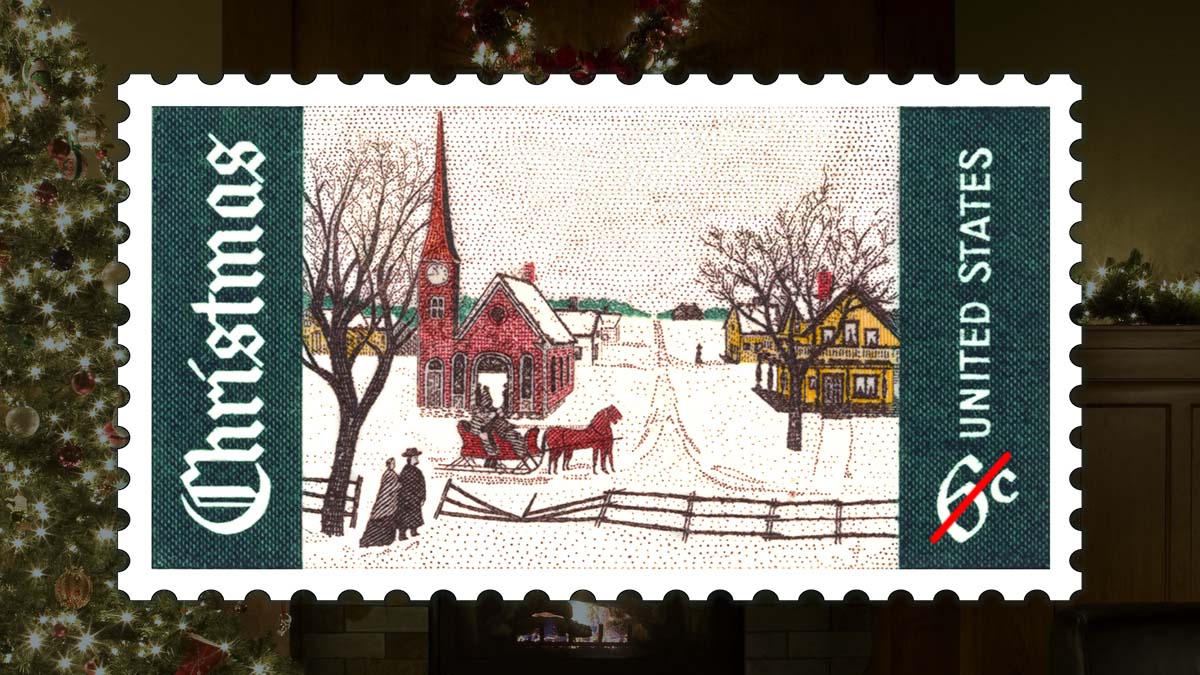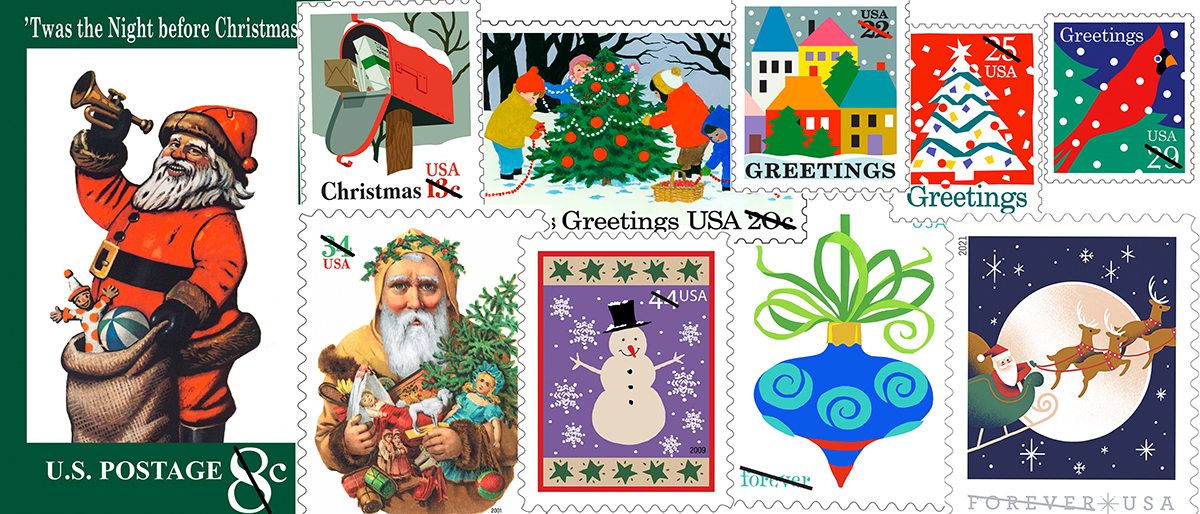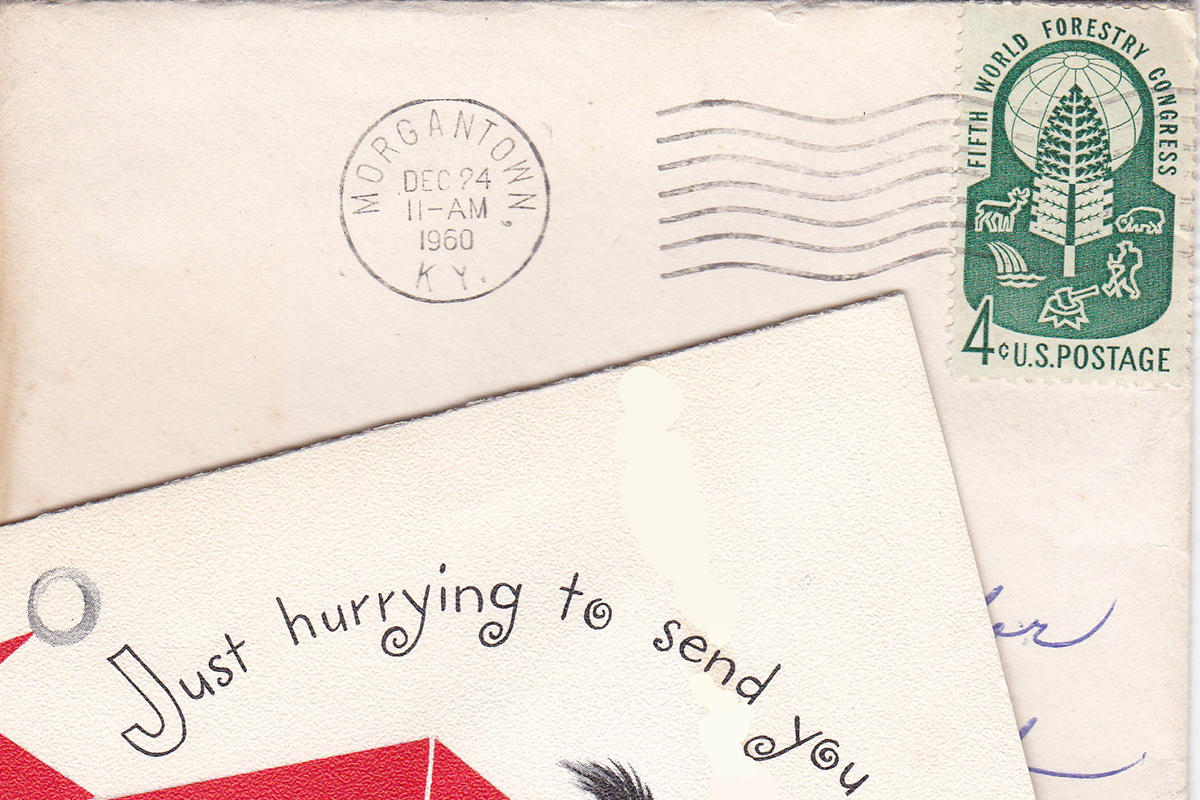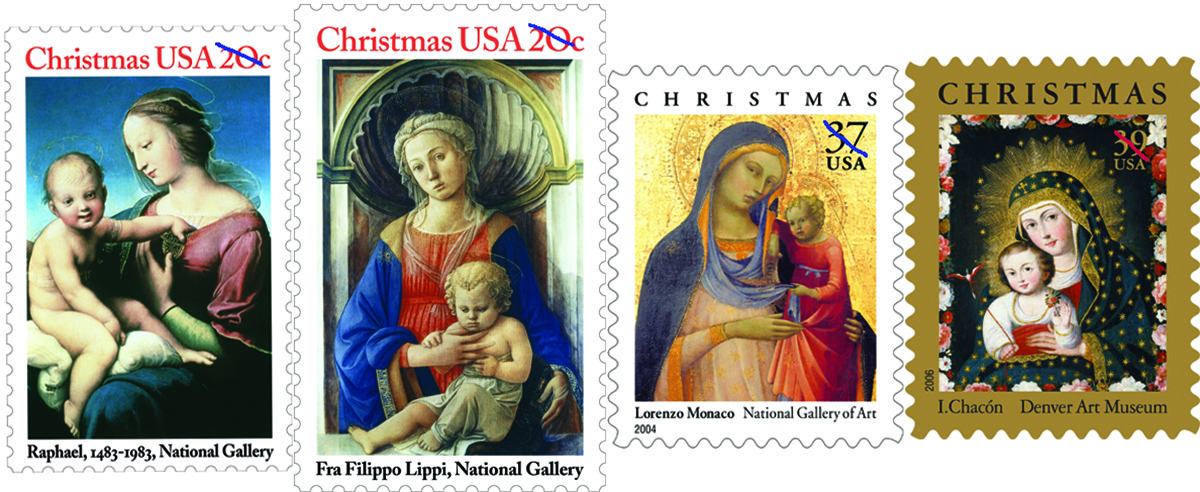
The Postal Service has helped celebrate Christmas with festive, seasonal stamps since 1962 when it issued its first Christmas stamp. Although customers had been asking for Christmas stamps for years, the first designs sparked controversy.

The first “Christmas stamps” were Christmas Seals
The first “Christmas stamps” in the United States weren’t postage stamps at all, but Christmas Seals — stamp look-alikes with no postage value, sold by charities to raise money. At first, Christmas Seals were commonly called “Christmas stamps.” A postal clerk in Denmark, Einar Holboell, came up with the idea of Christmas Seals while sorting Christmas cards for delivery in December 1903. At the time, money was desperately needed to build a hospital for children with tuberculosis (TB), a major, global public health threat. Why not ask people to buy a small sticker to decorate their holiday cards, to raise money for this charitable cause?
Holboell’s idea took root and was a huge success in Denmark. In 1907, an American Red Cross volunteer in Delaware, Emily Bissell, adopted the idea to raise money for a TB sanatorium in her state. In less than a month, more than $3,000 was raised, 10 times the fundraising goal. The next year, the Red Cross sold Christmas Seals nationwide, raising funds and awareness to fight TB. Postal officials reminded patrons not to place the Christmas “seals or stickers” on the address side of envelopes, to minimize confusion, but this advice was often not heeded. Christmas Seals are still sold today, now by the American Lung Association, helping make progress towards defeating asthma, lung cancer, influenza, tobacco use, air pollution, and other lung diseases, including COVID-19.
The early desire for Christmas-themed postage stamps
While Christmas Seals were a popular addition to Christmas mail, many customers wanted special Christmas-themed postage stamps. But despite repeated requests, for many years the Post Office Department balked, believing the cost of issuing stamps for use in only one season of the year would outweigh the benefits. Postal officials also feared many people would object to a stamp issued for a religious holiday, and worried that Christmas stamps would cut into the sales of Christmas Seals.
Although headquarters officials hesitated, postmasters were early advocates. In the 1930s and 1940s, at least two postmasters suggested the release of Christmas stamps — Joseph Conrad of Scranton, PA, and Leopold Morris of Victoria, TX. Both men pointed out that Christmas stamps would raise postage revenue and would also help more cards get delivered each Christmas, because more customers would choose to mail their cards as First-Class Mail, rather than at the cheaper, third-class rate. At the time, many people mailed Christmas cards in unsealed envelopes with no personal messages written on them, so the cards would qualify for third-class postage rates, which were 1 or 1½ cents cheaper. Unlike First-Class Mail, third-class mail was not returned or forwarded if it could not be delivered. In 1950, Morris estimated that 75 percent of Christmas cards were mailed at third-class rates and that thousands were destroyed each season because they were undeliverable. (In January 1968, the minimum postage rates for both third-class single-piece mail and First-Class Mail were raised to the same amount — 6 cents — nullifying the incentive for customers to mail greeting cards as third-class mail.)
In October 1939, the National Association of Postmasters passed a resolution at its annual convention calling for the release of a special Christmas stamp. Noting that the war in Europe might eventually “involve the entire Christian world,” the postmasters wanted the stamp to carry a message of “peace and goodwill.” They also noted the “incidental” benefit of discouraging the mailing of Christmas cards at third-class postage rates.
Christmas stamp stand-ins
Before the Post Office Department issued Christmas stamps, some customers mailed their holiday cards with Christmas stamp stand-ins. Some used a combination of red and green stamps to send holiday greetings. Others used stamps with holiday-like designs, like the 1960 stamp commemorating the Fifth World Forestry Conference, picturing what looked like a giant Christmas tree, and the Olympic Winter Games stamp, featuring a snowflake.

The first Christmas stamp, issued in 1962, sets sales record
In May 1962, Postmaster General J. Edward Day announced at the COMPEX stamp show in Chicago that the Post Office Department would issue a special stamp for Christmas “in response to heavy public demand.” He stated that the Department had been receiving nearly 1,000 requests annually for such a stamp. An article in the Oct. 11, 1962, issue of the Postal Bulletin explained that the stamp would serve a dual purpose: “It will make available an issue that is seasonably decorative and at the same time provide preferred handling for greeting cards.”
The first Christmas stamp — featuring a wreath, two candles, and the words “Christmas 1962” — was issued in Pittsburgh, at the annual convention of the National Association of Postmasters, on Nov. 1, 1962. At the dedication ceremony, Day stated it was the most-demanded stamp of any ever issued and that it would be the first in a series of annual Christmas stamps.
Anticipating a huge demand for the new stamp, the Department initially ordered 500 million printed — the largest number produced for a special stamp until that time. But demand for the stamp exceeded expectations. Thousands of Post Offices sold out, some within hours of placing them on sale. By the end of November, the Department upped the printing order to 650 million, and printers at the Bureau of Engraving and Printing began working around the clock to try to keep up with demand. By the time the presses stopped on Dec. 15, nearly 862 million of the stamps had been printed and distributed. James Kelleher, the special assistant to the postmaster general, called it “far and away from the best-selling special stamp ever issued.”
Sales records were broken again the next year by the second Christmas stamp issued, featuring the National Christmas Tree in front of the White House. Determined not to run out of stamps, the Department ordered 1,291,250,000 of the stamps printed — a new record. Again, sales were strong, with many postmasters reporting a 50 percent increase from the previous year.

Christmas stamp controversies
Despite their popularity, Christmas-themed stamps were not without controversy. Some people thought they were too religious, blurring the separation between church and state. Some thought the stamp designs weren’t religious enough. In an attempt to minimize controversy, for the first few years, the Post Office Department issued Christmas stamps with only nonreligious designs, featuring holiday greenery. Critics complained that by omitting the “reason for the season” the Department was commercializing Christmas.
The first decade was the toughest. A New York Times critic called the design of the 1962 stamp “artistically tedious.” That stamp, as well as the 1965 Christmas stamp, are listed in History.com’s article “The 11 Most Controversial Stamps in U.S. History.” The 1965 Christmas stamp featured the Angel Gabriel with such a feminine physique that some journalists quipped “he” should be called Gabrielle. Religious scholars were consulted, and opined that “angels are sexless.” Nevertheless, the media had a field day. The Chicago Tribune trumpeted “Stamp Bears Bosomy Gabriel.” (In response, a postal spokesman quipped: “Despite the potential controversy, we do not feel the Christmas stamp is a bust.”)
The design of the 1966 and 1967 Christmas stamps — the first to feature Madonna and Child — sparked even more controversy. In 1966, a representative of the American Jewish Congress urged the postmaster general not to issue the stamp. In 1967, Protestants and Other Americans United for Separation of Church and State sued Postmaster General Lawrence O’Brien, complaining that “the likeness of the Madonna is a religious symbol commonly associated with the Roman Catholic Church; and that, therefore, for the Government to issue such a postage stamp violates the First Amendment to the Constitution.” A federal judge dismissed the complaint, finding that the plaintiffs had no standing to sue.
In November 1970, the Postal Service first issued dual Christmas stamps — a “traditional” stamp with a religious theme and a “contemporary” stamp with a secular theme. Both traditional and contemporary holiday stamps have been issued regularly since then, giving customers greater choice when mailing holiday greetings. The traditional stamp has usually featured a famous painting of the Madonna and Child; for example, the Niccolini-Cowper Madonna by Raphael, issued in 1983 (below, far left), and Ignacio Chacon’s Madonna and Child with Bird, featured in 2006 (below, far right). Popular subjects of contemporary Christmas stamps have included toys, holiday decorations, and Santa Claus.
In a few years — for example, in 1974 and 1995 — more than two Christmas stamps have been issued. In 2000, no new Christmas stamps were issued, due to a large surplus remaining from the previous year. For a complete list of Christmas stamps, see Christmas Holiday Stamps.

Philatelic firsts
Several Christmas stamps hold philatelic distinctions. The 1964 Christmas stamps were the first “se-tenant” U.S. postage stamps, featuring four different designs printed in blocks of four. The 1974 “Peace on Earth” stamps were the first self-adhesive postage stamps in the United States, issued experimentally to see if they could reduce the fraudulent unsticking and reuse of stamps (the experiment failed, and self-adhesive stamps wouldn’t reappear until the 1990s). And the 1975 Christmas stamps were the first non-denominated U.S. postage stamps, printed with no postage value noted because of an uncertain-but-imminent price increase.
Other holiday stamps
In the 1990s, an increasing emphasis on respecting the diversity of the American people led the Postal Service to issue stamps celebrating additional holidays. In 1992, the first Lunar New Year stamp was issued. In 1996, the Postal Service launched the Holiday Celebrations stamp series, kicking it off with the first Hanukkah stamp, issued jointly with Israel. In 1997, the Postal Service issued the first stamp commemorating Kwanzaa, the African American celebration of family, community, and culture. Since then, other holidays celebrated in stamps have included Eid, Cinco de Mayo, Diwali, and Day of the Dead.
In 2021, the Christmas stamp tradition continues with A Visit From St. Nick, with four stamp designs depicting Santa Claus delivering toys on Christmas Eve.

Leave a comment
Your email address will not be published. Required fields are marked *